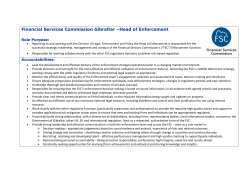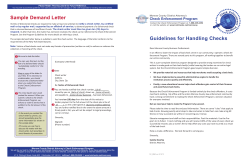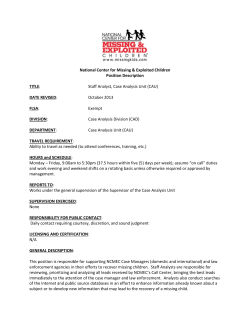
the KAMAN report - ATLAS Home
Korner Dear Board Member: Thank you to ALL our clients – the associations, boards, and their managers – those who hired us way back in 1980, those who have hired us over the years, and those who just chose Kaman & Cusimano as your community association lawyers. We are honored that you have continued to use us or just recently chose us. We know that you have entrusted us with your most valuable assets – your homes and your communities. We thank the hundreds of managers and thousands of board members who last year attended our educational town halls and seminars. We also appreciate that over 2100 of you have taken the time to watch the “Success Basics” webinar for new board members on ATLAS and especially appreciate the positive feedback and desire for more webinars. We appreciate your time and commitment to your communities. We learn by teaching, so by joining us you have helped us become better lawyers. During tough times, having the right law firm at your side is especially important. Kaman & Cusimano looks forward to continuing to serve as your community association lawyer in the coming year. We have set some ambitious goals for ourselves. We are committed to a continued expansion of our web-based ATLAS program with even more articles, forms, and blogs. We have started the process of expanding our Guide for Board Members of Community Associations as well as updating and combining it with our booklet on Reserves – What Every Board Member Needs to Know. The only thing constant in 2011 will be change and we will use our newsletters and seminars to keep you and your board informed and up-to-date on the never ending legal changes that affect your associations. We care!! As always, should you have questions of any nature, please do not hesitate to telephone me. Sincerely yours, DAVID W. KAMAN Kaman & Cusimano, LLC 2000 Terminal Tower 50 Public Square Cleveland, OH 44113 Kaman's the KAMAN report An update on current topics and issues affecting Ohio condominium and homeowner associations Kaman & CUSIMANO, LLC 2011 no. 1 INSIDE: Proper Steps To Covenant Enforcement Recent Successes For Our Clients Kaman's Korner The Kaman Report is published solely for ”Service Option“ clients of the firm of Kaman & Cusimano, LLC. The material presented herein is intended to provide general information and is not regarded as rendering specific advice to your particular community association. Please be aware that legal principles as may be referred to herein are subject to change from time to time. PROPER STEPS TO COVENANT ENFORCEMENT By Cullen J. Cottle, Esq. When making the decision to invest in a home within a deed restricted community association, purchasers must understand they are accepting more than just physical property. In conjunction with their purchase, new owners agree to abide by the restrictions detailed in the association’s governing documents. “Covenants” governing conduct are found in the Declaration, Bylaws, and Rules. The vast majority of owners understand this basic principal, and while reasonable minds may differ on what restrictions are important or fair, most, for the sake of their fellow neighbors, abide by the restrictions. Unfortunately, there are a select few residents in every community who must from time to time be forced to comply with an association’s rules. Just about every association has had, at one time or another, a covenant enforcement issue. Common examples include pets, parking, and leasing violations as well as unauthorized structures (such as sheds or fences) erected by owners without board consent. The steps to covenant enforcement include: 1.Initial Communication Kaman & Cusimano provides its clients with sample enforcement procedures and letters on ATLAS, our web-based Association Total Legal Assistance System. In any nonemergency enforcement matter, the first step is for the board to communicate the problem to the owner in a neighborly fashion. This “Friendly First Notice” can be generated by the board or the association’s property manager. In most cases, this single step is sufficient to remedy the problem. The letter should outline the nature of the violation and point to specific provisions in the governing documents that outlines the alleged violation. If the owner fails to respond, a “Mandated First Notice” should follow that reiterates the nature of the alleged violation, the board’s attempt to resolve the dispute in an amicable fashion, and set a clear deadline for the owner’s correction of the violation. 2.Enforcement Assessments An association may levy a reasonable monetary enforcement assessment for violations if the initial letters fail to gain compliance AND the board has ample evidence of the violation such as pictures or signed witness statements. Such assessments may accrue daily or per violation depending on the nature of the violation. Continued on page 2 PROPER STEPS TO COVENANT ENFORCEMENT Continued from page 1 A board must carefully review the association’s enforcement assessment procedure to make certain that it provides an owner with proper due process. Boards, for example, are required to provide a “Notice of Intent to Impose Enforcement Assessment” prior to levying the assessment on an owner’s account. This letter, which follows the first two notices outlined above, must also include language entitling an owner to a hearing and enclose a “Request for Hearing Form.” If an owner fails to request a hearing within ten (10) days, the board may impose the assessment to the owner’s account. Sample enforcement notices and a request for a hearing are also available on ATLAS. (See “Sample Forms – Enforcement Procedures”) 3.Self-Help Many Declarations contain what is commonly termed a “self-help” provision where an association is entitled to correct a violation so long as reasonable notice is provided in advance. Examples of self-help include, but are not limited to, hiring a contractor to remove an unapproved item or structure, towing a vehicle, or making required repairs to the property. In most instances, seventy-two (72) hours notice is sufficient. Kaman & Cusimano recommends that whenever self-help is necessary, a contractor should be hired to perform the service. In the case of removing and impounding personal property, we also recommend that local law enforcement be put on notice of the board’s intentions. The board should also be mindful 2 that it is responsible for properly preserving and storing any such property and that in most cases this can be done at the owner’s expense. If the board wants to tow or remove a vehicle from the property, separate State laws must be followed, which includes having tow away signs at all entrances to the community, that comply with State regulations. 4.When Self-Help is Impractical Some owners may resist the association’s efforts to correct a violation or interfere with contractors hired to complete the job. In cases where a confrontation is likely, the association may have to seek a court order granting the association access to the property. Kaman & Cusimano does not recommend “forcing” a situation to the point where tempers may flare and a dispute may escalate. The board should be prepared in advance for such a scenario and leave the owner’s property once it becomes clear a conflict is inevitable. In all such cases, a board representative or property manager should contact Kaman & Cusimano immediately to determine whether court intervention is necessary. At the very least, enforcement correspondence from Kaman & Cusimano should be directed to an owner reinforcing the need for compliance and setting forth a deadline. 5. Injunctive Relief When all other efforts have failed, the board should be prepared to seek a court order allowing access to the property to abate the violation. In Ohio, an injunction can be obtained to stop certain conduct or compel another to take action. Lawsuits are not typically filed without prior notice to the owner, and by following the above guidelines an association can be confident that a court of law will understand the board took all reasonable steps short of litigation to solve the problem. In general, the board must authorize Kaman & Cusimano to file a Complaint for Preliminary and Permanent Injunction together with a demand for reimbursement of all related costs and attorneys’ fees. To win the lawsuit and recover legal fees, proper and sufficient evidence of the violation must be presented and the right to recover costs must be set forth in the association’s governing documents. If the situation warrants, the association may also file a Motion for a Temporary Restraining Order to maintain the “status quo.” This may be appropriate in situations where an owner attempts or evidences intent to perform an action in violation of the Declaration which would cause significant and immediate harm to the community. Whether a Temporary Restraining Order is appropriate depends on a number of factors, all of which must be considered on a case-bycase basis. From “Friendly First Notices” to filing suit, it is clear Ohio law provides associations with a multitude of options when dealing with difficult residents in the community. The preferred approach in all instances is communication and problem resolution, not litigation. When litigation becomes necessary, however, each board member must understand that when the proper steps are followed it is the violating owner, not the board, who has fostered the impasse. By approaching enforcement matters in a fair and consistent manner, the board can feel assured that this perception is shared by fellow owners, the vast majority of whom understand the importance of honoring the restrictions contained within an association’s covenants. For more specific information, plan on attending our Spring seminar entitled “Enforcement of Rules.” RECENT SUCCESSES FOR OUR CLIENTS For the successful operation of a community association, we strongly believe and advocate “communication, not litigation.” Nonetheless, there have been instances where litigation is required to solve problems for an association. Recently, the attorneys of Kaman & Cusimano, LLC have: F Successfully argued that an owner was required to obtain approval from the association prior to making renovations in his unit. Facts – An association filed a lawsuit against an owner who was making extensive renovations to his unit including his bathroom and kitchen without obtaining approval from the association. The association’s restrictions require owners to obtain a permit prior to making any modifications to the interior of the unit to ensure that the modifications did not affect the common elements such as the plumbing. The owner claimed not to have knowledge of this restriction. Kaman & Cusimano successfully argued that the owner was required to obtain approval from the association for modifications to his unit and that he had constructive notice of the restrictions as they were filed with the county. The owner was required by the court to reimburse the association over $18,500.00 in legal fees. F Successfully argued that an owner was prohibited from parking his 3/4 ton pickup truck on the property. Facts – An owner filed a lawsuit against an association asking the court to permit him to park his 3/4 ton pickup truck in the common elements and limited common elements, which was prohibited by the association’s restrictions. The association filed a counterclaim asking the court to require the owners to remove the truck from the property or to park it in their garage. Kaman & Cusimano successfully argued that the association’s rule that the truck must be parked in the garage is reasonable. The court agreed and ordered the owners to park the truck in the garage or remove it from the property. Kaman & Cusimano also obtained $4,500.00 in attorneys’ fees on behalf of the association. F Successfully argued in the 9th District Court of Appeals that Ohio Revised Code Section 5311.18 permits foreclosure and prohibits owner’s counterclaim for failure to maintain common elements. Facts – An owner was delinquent in paying common assessments. Kaman & Cusimano filed a lien against the unit. As the owner’s delinquent account accrued, Kaman & Cusimano filed a Complaint for Foreclosure requesting that the unit be sold at sheriff’s sale. The owner filed a counterclaim against the association alleging the association failed to maintain the common elements. Kaman & Cusimano successfully argued in the Court of Common Pleas and again in the Court of Appeals that pursuant to Ohio Revised Code Section 5311.18, the owner’s counterclaim was impermissible under the statute and should be dismissed. The owner’s obligation to pay assessments is mandatory as a member of the association. Payment of assessments is an obligation separate and distinct from the association’s duty to maintain the common elements. Kaman & Cusimano successfully argued the association could proceed with its foreclosure to recover the unpaid assessments regardless of the owner’s claims. The Court of Appeals ordered the Court of Common Pleas to proceed with its order for sale of the unit. F Successfully recovered funds from a siding contractor that improperly installed the siding causing premature deterioration. Facts – An association noticed cracking and breaking of siding that was recently installed within the association. The association obtained an engineer’s report which identified several installation deficiencies. Therefore, the association filed a lawsuit against the contractor for breach of contract and negligence. Kaman & Cusimano successfully settled the matter with the contractor agreeing to pay $11,500.00 to the association for damages. F Successfully defended a claim of discrimination where an owner alleged that the association refused to provide her with services due to her race. Facts – An owner filed a civil rights complaint against the association claiming discrimination based on race and claiming that the association refused to provide her with snowplow services and perform maintenance to her unit. Kaman & Cusimano successfully argued that the association reviews maintenance requests on a caseby-case basis and determines what items are in need of immediate repair and are within the association’s budget and that the owner’s vehicle being parked in her driveway prohibited the snowplow contractor from removing the snow in her driveway. F Successfully defended a claim of discrimination where an employee claimed that he was demoted due to his race. Facts – An owner within an association filed a civil rights complaint against the association claiming that he was demoted based on race. Kaman & Cusimano successfully argued that the employee’s work evaluations showed that he was performing his job unsatisfactorily and failed to improve after his work evaluation and several warnings. 3
© Copyright 2025









